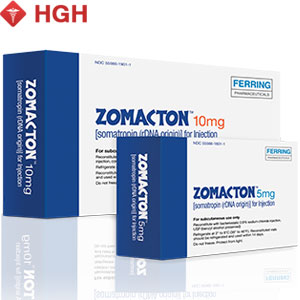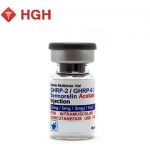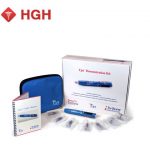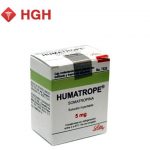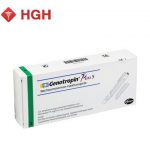
Adult-onset growth hormone deficiency occurs when the body is not producing adequate growth hormone (HGH). It is also known as adult HGH deficiency, growth hormone deficiency, GHD and adult growth hormone deficiency syndrome. Low HGH levels in adults can result in a number of symptoms that increase the risk of problems like heart disease. HGH can be treated in most cases.
What Is HGH Deficiency?
HGH is a hormone produced by the anterior pituitary gland in the brain. In childhood, the hormone is responsible for stimulating normal growth and development. As the first step in the process, the release of HGH stimulates the release of a second hormone, insulin-like growth factor 1 (IGF1). Produced in the liver, IGF1 interacts with and mediates HGH to produce the typical growth spurt of puberty. If the hormone is deficient in childhood, dwarfism results. In adulthood, HGH continues to affect various metabolic processes. HGH deficiency in adulthood can adversely affect fat metabolism and muscle mass, and increase the risk of osteoporosis and heart disease. As many as 6,000 people in the US are diagnosed with HGH deficiency each year. Many more may be undiagnosed.
Low, Normal and High Growth Hormone Levels
Although the signs of dwarfism are visibly apparent, the only way to confirm whether HGH levels are abnormal is through laboratory tests. In most cases, HGH deficiency is confirmed by testing for associated hormones such as IGF1. HGH levels vary according to age, sex and other factors such as obesity. The normal range for men is 0.01-0.97 ng/mL. For women the normal range is 0.01-3.61 ng/mL. Additional laboratory tests used to diagnose HGH deficiency include the HGH suppression test, IGF-1 and IGFBP-3 tests and tests for levels of related hormones such as cortisol, prolactin and testosterone.
Average HGH Levels in Men by Age
| Age | Levels ng/mL |
|---|---|
| Over 30 | 132 – 333 |
| Over 40 | 121 – 237 |
| Over 50 | 68 – 245 |
| Over 60 | 60 – 220 |
| Over 70 | 36 – 215 |
What Causes Low HGH Levels?
The most common causes of low HGH levels involve damage to the pituitary gland. Pituitary tumors, severe head injuries and auto-immune diseases can cause pituitary damage. Sometime there is no obvious reason for HGH deficiency. This kind of condition is called idiopathic HGH deficiency. In adults, HGH deficiency may be associated with aging. While a decrease in HGH is feature of normal aging, in some people symptoms are severe, suggesting another mechanism is at work.
Signs of Low HGH Levels
There are many signs and symptoms of HGH deficiency in adults. They may be subtle and make it difficult to confirm what's going on. Many of these are a part of the normal aging process as well.
Abnormal signs and symptoms include:
- Decrease in muscle size and strength.
- Increase in abdominal fat.
- Changes in cholesterol levels as well as abnormalities in the blood.
- Osteoporosis – bone thinning – and increased risk of fractures.
- Increased sensitivity to heat and cold.
- Decreased energy and stamina.
- Inability to concentrate and remember information.
- Anxiety, depression, feelings of isolation and decreased sexual interest are common.
- Changes in the make up of the blood cholesterol.
How is Growth Hormone Deficiency Diagnosed?
Although lab tests can be helpful, the signs and symptoms of HGH deficiency are also important in making a diagnosis. Your doctor will take a very complete health history and perform an examination that includes muscle strength testing, as well as lab work and possible X-rays. Many doctors don't know exactly how to test for low HGH levels, so you may be referred to a specialist called an endocrinologist for testing and diagnosis. The severity of symptoms is often the determining factor in the diagnosis and decision to supplement with HGH hormone injections. For example, some degree of osteoporosis is normal in older adults. Severe osteoporosis in the absence of a family history or life habits that decrease bone mass can be an indicator of HGH deficiency. A Dexa-scan is a special X-ray that can show whether osteoporosis exists. One commonly-used blood test is the insulin tolerance test. An injection of insulin will lower the blood sugar level, which normally causes the body to release HGH. If the patient fails to produce HGH in response to the low blood sugar levels, it indicates an HGH deficiency.
Types of HGH Deficiency Treatment
Growth hormone replacement therapy is the standard treatment for adult-onset HGH deficiency. The medication requires a prescription. HGH is injected into the skin of the abdomen. Daily injections are required. In addition, most doctors recommend lifestyle changes such as weight loss. A healthy diet that is rich in vitamin D and calcium is helpful for osteoporosis. Adequate sleep and exercise also make a difference in muscle strength, bone density and overall health.
If you suspect you have adult-onset HGH deficiency, see a doctor who specializes in hormonal conditions. You can only obtain HGH injections with a prescription. HGH is not used to improve athletic performance. Make sure you obtain your HGH from a reputable source.
